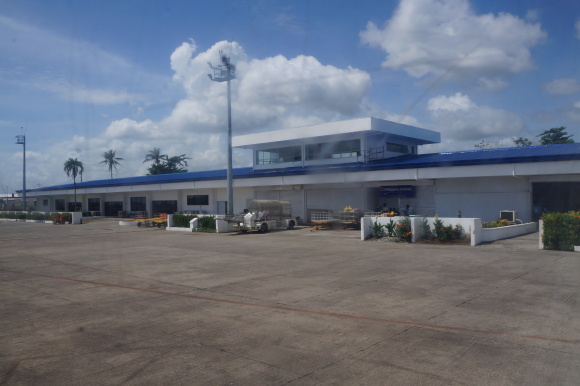Thanks to newfound friends, I was able to visit Tacloban and parts of Samar and Leyte in time for the first anniversary of epic supertyphoon Yolanda (Haiyan).
By newfound friends, I refer to folks at Plan International Philippines, who organized a media tour mostly for journalists and for this blogger. It gave me a chance to see the pace of recovery, rehabilitation and reconstruction efforts a year after the world’s strongest storm devastated our country. By design, the media tour sought to showcase Plan’s work among the good people of Eastern Visayas: The schedules and itineraries were tight, but we all took as much as we could to get a pulse of our kababayans, especially the kids and young people.
So what did I see?
Touchdown in Tacloban City
As the plane made its final approach towards Tacloban City’s Daniel Z. Romualdez Airport (TAC) at just before lunch, we got to see the city from a higher vantage point. Tents dotted the city, along with shiny GI sheets (yero) mostly for what we would know later as “transitional houses”.


The Tacloban airport’s passenger terminal has since been renovated, after being damaged by the supertyphoon.


The Civil Aviation Authority of the Philippines suspended all flights to Tacloban in early September 2014 because of damaged portions of the runway.
The repairs are still ongoing and the airport’s runway could accommodate only the lighter turbo-prop planes. Only after the repairs are done could the CAAP allow flights by the heavier Airbus A319/320 and Boeing 737 planes. Cebu Pacific uses ATR-72-500 planes (capacity: 72 pax), while Philippine Airlines serves the route with the 76-seater Bombardier Q400s.
The 25-meter Burayan Bridge, which connects the airport to the city, is also still being reconstructed. Only one lane is available for motorists and commuters.

Cellular and mobile data
Both Globe and Smart appear to have restored 2G cellular service in most parts of Tacloban City, but 3G remains spotty even in the downtown area. LTE signal is available but only in limited downtown areas and the speeds are not as fast as we would expect from LTE. The telcos have blanketed the city with tarpaulin and plastic streamers pitching their special Visayas promo offers.
Taclobanons are waiting for the restoration of jet services at their airport. We can be sure the temporary ban on jets due to the damaged runway has an impact on the transport of people and products. As for telecommunications, we could only hope that Globe and Smart would provide true LTE coverage (and speeds), further improve their 3G coverage across all of Tacloban, and bridge the many 3G dead spots.
The great people of Tacloban
Taclobanons are bouncing back and we could feel the pulse in the public market by the bay and the decades-old barbeque stands nearby. They always have a ready smile. Colleges and universities in the city have also since reopened. Some are temporarily employed in cash-for-work, while other have set up their own stores in the city. Downtown is alive and kicking: Hurrah for the Taclobanons and Warays who are scrappy, palaban, hardworking, creative and full of faith!
First impressions
A full year after Yolanda, the city still bears many marks of the terrible devastation wrought by the supertyphoon. There are many houses and buildings still left untouched, some torn roofs, others with shattered windows and tents. As we moved away from the city center, we saw more and more tents, and houses patched up by tarpaulin or “trapal”. More needs to be done.
There are also “no build zone” signages in many places of the city where people are living or working. I wonder if the government would demolish or relocate not just the dwellings of poor and middle-class residents in those “no build zones”. There are also private real-estate developments and big business buildings in such zones.
Tacloban is still the epicenter of international humanitarian aid work in Eastern Visayas: It is home to the United Nations House where UN agencies working in Eastern Visayas are all operating from, and other international agencies have set up headquarters in different parts of the downtown and even the peripheries of the city. Plan International has two offices in downtown Tacloban: its regular office and its emergency response headquarters.
I don’t know if it really matters that Tacloban has a mayor with the surname Romualdez and the rest of the Philippines has a president named BS Aquino — but there’s no highly-visible or high-profile presence of national government agencies. You would only see the logos of the DPWH and DSWD in signages put up for international NGO or UN projects where they cooperate. There’s no compelling explanation why BS Aquino decided to skip Tacloban, the regional capital, except perhaps for the fact that he would be hounded by big, 20,000-strong protest actions of Yolanda survivors incensed by his administrations slow, slothful response to the disaster.
Part 2 – #RememberHaiyan Diaries: Build Back Better
Part 3 – #RememberHaiyan Diaries: The new normal after Yolanda
Elsewhere: Resilient? (Manila Bulletin)
(Acknowledgment: Thanks to Plan International Philippines for inviting me to join its media tour. The international NGO provided airfare, airport transfer, accommodations, land transportation, meals, and the itinerary for this media tour. The view expressed in my posts are my own, except for the quotes directly attributed to spokespersons of Plan International Philippines and other possible sources.)
